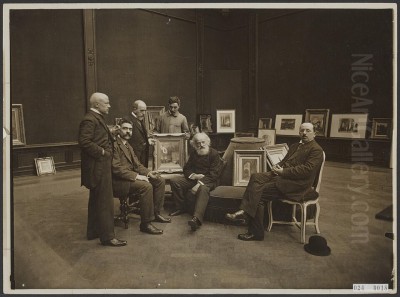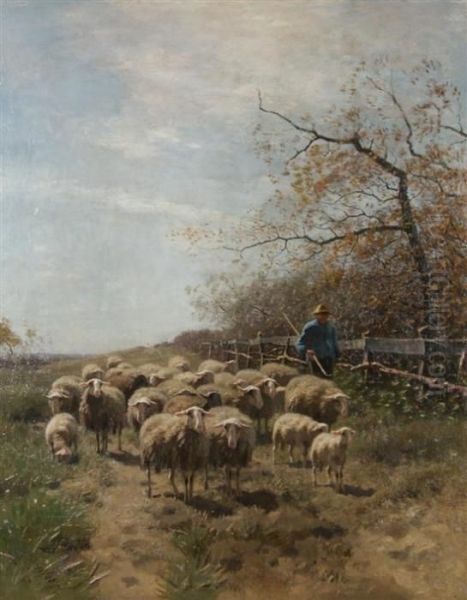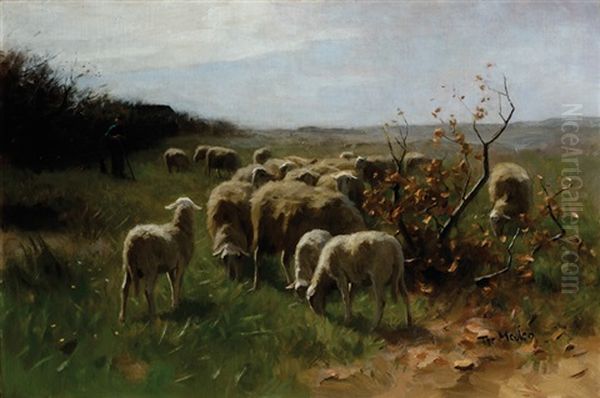
Francois Pieter ter Meulen (1843-1927) stands as a significant figure in Dutch art, particularly renowned for his evocative landscape paintings and tender portrayals of pastoral life. Born in Bodegraven and passing away in The Hague, his artistic journey coincided with a vibrant period in Dutch painting, most notably the rise and flourishing of the Hague School. Ter Meulen carved a distinct niche for himself with his specialization in scenes featuring sheep and shepherds, capturing the tranquil essence of the Dutch countryside with a sensitivity that continues to resonate with art enthusiasts and collectors.
His works are characterized by a profound appreciation for nature, a meticulous attention to detail, and a masterful handling of light and atmosphere. As an important member of the Hague School, he contributed to a movement that sought to represent the Dutch landscape and its inhabitants with a new sense of realism and emotional depth, moving away from the idealized portrayals of earlier Romanticism. Ter Meulen's legacy is preserved not only in his numerous canvases but also in his influence on the trajectory of Dutch modernism.
Early Life and Artistic Formation
Francois Pieter ter Meulen's artistic journey began in Bodegraven, a town in South Holland, where he was born in 1843. His formal artistic training was significantly shaped by his studies under Hendrik van de Sande Bakhuyzen (1795-1860). Bakhuyzen himself was a respected painter known for his landscapes, often featuring cattle, and his detailed, somewhat Romantic style provided a solid foundation for the young ter Meulen. Although Bakhuyzen passed away when ter Meulen was still relatively young, the principles of careful observation and dedication to landscape art would have been instilled early on.

This tutelage under Bakhuyzen placed ter Meulen within a lineage of Dutch landscape painting that valued both technical skill and an intimate connection with the local environment. The Netherlands, with its unique interplay of water, sky, and flat terrain, has long inspired its artists, and ter Meulen was to become a notable interpreter of its more pastoral aspects. His early development occurred during a period when Dutch art was seeking to redefine its national identity, looking to its own traditions and distinctive scenery.
The Hague School and its Ethos
The latter half of the 19th century saw the emergence of the Hague School, a pivotal movement in Dutch art. This group of artists, active roughly between 1860 and 1890, sought to capture the everyday reality of Dutch life and landscape with an unembellished honesty. They were inspired by the French Barbizon School painters, such as Jean-Baptiste-Camille Corot, Jean-François Millet, and Charles-François Daubigny, who advocated for painting outdoors (en plein air) and depicting rural life with dignity.
The Hague School artists turned their attention to the muted colours and atmospheric light of the Dutch coast, polders, and interiors. Key figures included Jozef Israëls, known for his poignant scenes of fishing communities; the Maris brothers—Jacob, Matthijs, and Willem—each with their distinct specializations in cityscapes, mystical figures, and luminous landscapes with cattle, respectively. Anton Mauve, a cousin-in-law of Vincent van Gogh and a significant influence on him, was celebrated for his gentle depictions of sheep and rural lanes.
Other prominent members were Hendrik Willem Mesdag, famous for his seascapes and the monumental Panorama Mesdag; Johannes Bosboom, who specialized in church interiors; Paul Gabriël, known for his polder landscapes often featuring windmills; and Johannes Weissenbruch, a master of capturing the expansive Dutch skies and waterways. These artists shared a common desire to convey mood and atmosphere, often employing a palette of greys, browns, and soft blues, which led to the school sometimes being referred to as the "Grey School."
Ter Meulen's Place within the Hague School
Francois Pieter ter Meulen was an integral part of this artistic milieu. He fully embraced the Hague School's commitment to realism and its focus on the Dutch landscape. While some of his contemporaries focused on coastal scenes or urban views, ter Meulen found his primary inspiration in the inland pastoral landscapes, particularly those populated by sheep and their guardians. His work aligned perfectly with the school's ethos of portraying the simple, unadorned beauty of the Netherlands.

His paintings often evoke a sense of quietude and harmony, reflecting the Hague School's characteristic emphasis on mood over precise topographical detail. Like Anton Mauve, ter Meulen became particularly associated with sheep, but he developed his own distinct approach to the subject. His compositions are carefully constructed, and his rendering of animal anatomy and the textures of wool and foliage demonstrates a keen observational skill. He was active throughout the late 19th century, a period when the Hague School was at its zenith, and his contributions helped solidify its reputation.
Thematic Focus: The Pastoral Ideal
The recurring motif in Francois Pieter ter Meulen's oeuvre is the pastoral scene, with a particular emphasis on sheep. Works such as "Shepherding," "Flock of Sheep," "Sheep Grazing in the Wood," and "The Shepherd" are emblematic of his thematic concerns. These paintings are not merely animal studies; they are evocations of a way of life, a timeless connection between humans, animals, and the land. The shepherd, often a solitary figure, becomes a symbol of quiet diligence and harmony with nature.
His depictions of "Cows in Meadow" also highlight his interest in rural life and livestock, common themes within the Hague School, shared by artists like Willem Maris. Ter Meulen's landscapes are typically serene, often bathed in the soft, diffused light characteristic of the Dutch climate. He captured the changing seasons, from the lush greens of summer to the more muted tones of autumn and winter, always with an eye for the subtle interplay of light and shadow. This focus on the tranquil and the idyllic offered a counterpoint to the increasing industrialization of the era.
The choice of sheep as a central subject was popular among Hague School painters, notably Anton Mauve. For ter Meulen, these animals provided an opportunity to explore texture, movement, and the dynamics of a flock within the landscape. His paintings often convey a sense of peace and timelessness, inviting the viewer to contemplate the enduring rhythms of nature.
Artistic Style and Technique
Ter Meulen's artistic style is characterized by its refined realism and atmospheric sensitivity. He typically worked in oil on canvas, employing a technique that balanced detailed rendering with a broader, more suggestive handling of the overall scene. His brushwork, while capable of capturing fine details like the texture of wool or the bark of a tree, also contributed to the overall mood and unity of the composition.
A hallmark of his style is the masterful depiction of light. Whether it's the soft glow of an overcast day, the dappled sunlight filtering through trees, or the cool light of early morning, ter Meulen skillfully used light to define form, create depth, and enhance the emotional tone of his paintings. His color palette, while often favoring the muted greys, greens, and browns typical of the Hague School, could also incorporate subtle blues and warmer earth tones, always harmoniously blended.
His compositions are thoughtfully arranged, often leading the viewer's eye into the landscape through winding paths or the arrangement of the flock. There is a sense of balance and order in his works, even when depicting the apparent randomness of nature. This careful construction, combined with his sensitive portrayal of atmosphere, gives his paintings a lasting appeal. His dedication to capturing the "true" Dutch atmosphere aligns him with contemporaries like J.H. Weissenbruch, who was also a master of light and sky.
Notable Works and Their Characteristics
Several of Francois Pieter ter Meulen's works have gained recognition and frequently appear in collections and at auction. "Shepherding" (also sometimes referred to as "The Shepherd") is perhaps one of his most iconic themes, and various versions of this subject exist. One such painting achieved a notable auction price of $9,760, underscoring the continued appreciation for his work. These paintings typically feature a shepherd, often with a dog, guiding a flock of sheep through a wooded or open landscape. The focus is on the gentle movement of the flock and the tranquil atmosphere of the scene.
"Cows in Meadow" showcases his ability to depict other livestock within the characteristic Dutch polder landscape. These works often emphasize the vastness of the sky and the lushness of the pastureland, themes also explored by artists like Willem Maris and Paul Gabriël. The cattle are rendered with anatomical accuracy and a sense of placid contentment.
"Flock of Sheep" and "Sheep Grazing in the Wood" are titles that recur, indicating his sustained engagement with this subject. In wooded scenes, ter Meulen excelled at capturing the play of light filtering through leaves, creating a dappled effect on the backs of the sheep and the forest floor. The sense of depth and the enclosure of the woods provide a different ambiance compared to his more open meadow scenes.
"Timber Clearing" (or similar titles suggesting woodland management) indicates another facet of his observation of rural activities. These scenes might depict felled trees or workers, adding a human element beyond the shepherd, and showcasing his versatility in capturing different aspects of the countryside. Each work, regardless of the specific title, reflects his consistent dedication to portraying the serene beauty of rural Holland.
Collaboration and Contemporaries
While direct records of extensive collaborations might be sparse, ter Meulen's artistic development was undoubtedly shaped by his interactions with fellow Hague School artists. His association with Anton Mauve (1838-1888) is particularly noteworthy. Mauve was a leading figure in the Hague School and a master of pastoral scenes, especially those featuring sheep. It is known that ter Meulen worked in Laren, a village that became an artists' colony, alongside Mauve. This period in Laren, which also attracted artists like Albert Neuhuys, who focused on peasant interiors and family life, would have been a time of shared ideas and mutual influence.
In Laren, ter Meulen is also noted to have worked with Jan van Enschede and Herman van de Weele, further embedding him within a community of artists dedicated to similar themes and approaches. The Laren School, as it came to be known, was in many ways an extension or offshoot of the Hague School, focusing on the heathlands and rural life around the village.
Beyond these direct associations, ter Meulen was part of the broader artistic current of the Hague School. He would have exhibited alongside, and been familiar with the works of, all its major proponents: Jozef Israëls, the Maris brothers (Jacob, Matthijs, and Willem), Hendrik Willem Mesdag, George Hendrik Breitner (who, though younger, started within the Hague School before moving towards Amsterdam Impressionism), Johannes Bosboom, and Willem Roelofs. The artistic environment of The Hague at this time was vibrant, with societies like the Pulchri Studio providing a venue for artists to meet, exhibit, and exchange ideas.
The influence of the Barbizon painters, such as Constant Troyon, known for his animal paintings, and Charles Jacque, also a painter of sheep, was pervasive among the Hague School artists, including ter Meulen. These French artists provided a model for a more direct and unidealized approach to landscape and rural subjects.
Legacy and Market Reception
Francois Pieter ter Meulen's works continue to be appreciated for their quiet beauty and skillful execution. His paintings are held in various public and private collections, particularly in the Netherlands, and regularly appear at auctions, where they command respectable prices. The consistent demand for his pastoral scenes, especially those featuring sheep, attests to their enduring appeal. His depiction of "Shepherding" fetching nearly ten thousand dollars at auction is a testament to his recognized status among collectors of Hague School art.
His legacy lies in his contribution to the Hague School's distinctive vision of the Dutch landscape. He, along with artists like Mauve and Willem Maris, helped to define a particular genre of pastoral painting that was both quintessentially Dutch and aligned with broader European trends towards realism. While perhaps not as revolutionary as some of his contemporaries who pushed towards Impressionism or other avant-garde movements, ter Meulen's dedication to his chosen themes and his consistent quality make him an important representative of his era.
The Hague School as a whole played a crucial role in revitalizing Dutch art in the 19th century, and it laid some of the groundwork for later developments, including the work of artists like Vincent van Gogh, who was directly influenced by Mauve and admired the Hague School's sincerity. Ter Meulen's art, with its emphasis on atmosphere, light, and the tranquil aspects of nature, contributed to this rich artistic tapestry. His paintings offer a window into a more serene, pastoral Holland, captured with an artist's loving and observant eye.
Conclusion: An Enduring Vision of Tranquility
Francois Pieter ter Meulen remains a cherished figure in the narrative of Dutch art, a painter who dedicated his considerable talents to capturing the gentle soul of the pastoral Netherlands. As a key member of the Hague School, he shared in its mission to portray the national landscape and its life with honesty and atmospheric depth. His particular focus on sheep and shepherds, rendered with meticulous care and a profound sense of peace, has ensured his lasting recognition.
His artistic education under Hendrik van de Sande Bakhuyzen provided a firm grounding, while his association with luminaries like Anton Mauve and his participation in the artistic communities of The Hague and Laren enriched his practice. Working alongside contemporaries such as the Maris brothers, Jozef Israëls, and J.H. Weissenbruch, ter Meulen contributed to a distinctly Dutch form of realism that valued mood and light above all.
Today, the paintings of Francois Pieter ter Meulen continue to evoke a sense of calm and a deep appreciation for the natural world. His depictions of sun-dappled woods, open meadows, and contented flocks serve as a timeless reminder of the enduring beauty found in the quiet corners of the landscape, solidifying his place as a master of pastoral serenity in Dutch art history.